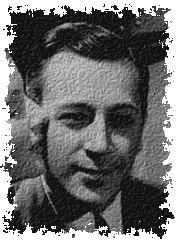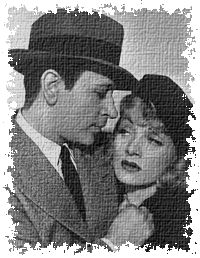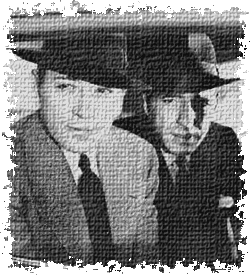


By Bob Byrne
|
OK, I'll admit that the title is a bit of an over-simplification. However, in the annals of Hollywood, never has one actor so torpedoed his own career, while making another actor a star at the same time. Let's take a look at how this happened. George Raft grew up in Hell's Kitchen, New York, where he was a childhood friend of Owney Madden. Madden would become a powerful mobster in the days of Prohibition. Raft toyed with being a boxer, then taught himself to dance. He hit it big in Vaudeville in the early twenties and was a top dancer. At the same time, he hung out with professional gangsters, gaining entry through his friendship with Downey. He studied how they walked and talked, and mastered the art of imitating their mannerisms.
He became a star. He had the lead in a 1935 version of Dashiell Hammett's The Glass Key. However, it is Alan Ladd's portrayal in 1942 that is remembered. In 1937, he turned down the role of Baby Face Martin in Dead End. He felt Martin wasn't sympathetic enough, and he didn't like the way Martin's mother slapped him in the movie. Bogart was given the part and got good reviews. It was directed by William Wyler, who would tap Bogart again for his very successful role in The Desperate Hours. Raft rejects a role and Humphrey Bogart takes it. I think we have a pattern. He signed with Warner Brothers in 1939 as part of their "Murder's Row." Paul Muni, James Cagney and Edward G. Robinson were already at Warners. And a guy named Bogart played supporting roles in which he was usually gunned down by the star. Word is that as soon as Raft signed with Warners, he bumped Bogart out of the "Hood Stacey" role in Each Dawn I Die, with Jimmy Cagney. The careers of Bogart and Raft would be inextricably linked for the next three years. In 1939, Raft and Bogart made a forgettable film called Invisible Stripes. They are brothers and both are gunned down by other mobsters. It was one of seven films Bogart made that year. He was shot to death in four of them; sentenced to be electrocuted in another; and actually electrocuted, brought back to life, then shot down again in another. He wasn't exactly getting star quality parts. In 1940, Raft would star in They Drive By Night. Bogart played his brother in a trucker film. Ida Lupino was the star of the movie, breaking down in a courtroom scene late in the film. That same year, Raft turned down the lead in a gangster comedy called It All Came True. Bogart took the part. It wasn't a very memorable film.
Instead, he made Manpower, with Bogart in a supporting role. He wasn't happy with Bogart and had him removed from the film just after shooting started. Bogart was upset but was not reinstated. Edward G. Robinson replaced him and ended up in a fight with Raft. The movie was mediocre. Raft was 0 for 2. He did make one good decision that year: he refused to make The Wagons Roll at Night, which starred Bogart instead. It was a circus movie, and it was as bad as High Sierra was good. But next, Raft made a mistake that effectively ended his run as a top dog at Warners. John Huston had worked on several successful screenplays for Warners, so they "threw him a bone" and let him direct a movie. He chose to do Dashiell Hammet's private eye novel, The Maltese Falcon. Raft was tagged for the lead. He wrote a letter to Jack Warner, telling him that Warner had promised that Raft would only have to play in important films, He also didn't want to entrust his career to a rookie director. Finally, it was a remake, which he didn't have to make, according to his contract (that was how he got out of The Wagons Roll at Night). On the surface, Raft's reasoning was sound. There had been two prior versions of the movie. In 1931, Ricardo Cortez starred in a sort of "Thin Man" version of the tale. It didn't work. In 1936, the story was changed around and Bette Davis starred in Satan Met a Lady. Strike two. Raft had every reason to believe that the next remake would be a flop as well. But Huston didn't want to rewrite the novel. He used much of the dialogue directly from the story, and he didn't turn it into a comedy. The Maltese Falcon is still regarded as the finest detective film ever made. Bogart formed a lifelong friendship with John Huston that resulted in some of his greatest movies. Raft had missed a golden opportunity to make up for his mistake in passing over High Sierra.
Bogart's very next film was The Big Shot. Yep, you guessed it: Raft turned this down, saying he didn't want to do gangster films anymore. It wasn't much of a movie, and it showed that Warners still didn't quite know what to do with Bogart. Meanwhile, Raft made only one movie in 1942: a musical with Pat O'Brien called Broadway. I don't believe it's even shown on late night cable television. Well, we're up to Casablanca. It's not clear whether Raft wanted to play Rick Blaine or not. A memo does exist, in which Jack Warner asks studio exec Hal Wallis what he thought about using George for the part. Wallis replied that it was being written for Bogart, and that was the end of the topic. Casablanca made Humphrey Bogart a legend (even though Paul Lukas won the Oscar for his performance for Watch on the Rhine. Ever seen it? Nope, me either.). In 1943, Raft made his own version of Casablanca. It was called Background to Danger. American Joe Barton fights the Nazis in World War II Turkey, and the movie features Sydney Greenstreet and Peter Lorre. It wasn't a hit. His career was pretty much done. Raft had a nice part in Marilyn Monroe's Some Like It Hot. The George Raft Story was made in 1961, and a character in Francis Ford Coppola's Cotton Club was based on Raft (Richard Gere played that part). Ironically, his last part was in 1980's The Man With Bogart's Face. A private eye has surgery so that he looks like Bogart. Raft has twelfth billing in a film which feature's Bogart's name in the title. How about that? Raft couldn't read, and it has been asserted that he turned down some scripts because he couldn't fully comprehend the character. Also, because he knew so many gangsters and was a part of their circle, he didn't like playing them on screen. Take away High Sierra and The Maltese Flacon, and Bogart probably doesn't become a star. He might not even have been cast in Casablanca. In 1939, Raft was making $5,500 per week, which was more than fellow Warners stars Errol Flynn and Pat O'Brien (Cagney got $12,500, Robinson $8,500). Humphrey Bogart was getting $1,250 per week, less than John Garfield, George Brent and Donald Crisp (he made over 130 movies, including four with Bogart). Bogart had made twenty-five films, with only The Petrified Forest being somewhat memorable. In a three-year period, George Raft sabotaged himself and helped Humphrey Bogart launch a career that has resulted in him being regarded as the greatest actor of all time. Maybe George should have kept dancing in films. |
[Reproduced, with permission, from Sherlock Holmes on Oxford Lane]
 After appearing in a few films as a dancer, he broke through in 1932. Long before Rod Steiger and Al Pacino played Capone roles, Paul Muni made a classic gangster film: Scarface Shame of a Nation. Raft had a part as Rinaldo, a coin-flipping gunman. Raft played a great gangster because he had many real life friends to base them on.
After appearing in a few films as a dancer, he broke through in 1932. Long before Rod Steiger and Al Pacino played Capone roles, Paul Muni made a classic gangster film: Scarface Shame of a Nation. Raft had a part as Rinaldo, a coin-flipping gunman. Raft played a great gangster because he had many real life friends to base them on.
 It was in 1941 that Raft made Bogart a star. Young John Huston co-wrote the script to High Sierra. Raft turned it down, saying he didn't want to play a gangster. Also, he didn't like the fact that Roy Earle died at the end of the film. Paul Muni was fighting with Warners and also turned it down. Rumor has it Cagney and Robinson did the same. So Humphrey Bogart was cast opposite Ida Lupino (who got top billing). Bogart received rave reviews as the criminal with a heart of gold. Critics and fans loved him. Raft had blown a chance to star in a hit film.
It was in 1941 that Raft made Bogart a star. Young John Huston co-wrote the script to High Sierra. Raft turned it down, saying he didn't want to play a gangster. Also, he didn't like the fact that Roy Earle died at the end of the film. Paul Muni was fighting with Warners and also turned it down. Rumor has it Cagney and Robinson did the same. So Humphrey Bogart was cast opposite Ida Lupino (who got top billing). Bogart received rave reviews as the criminal with a heart of gold. Critics and fans loved him. Raft had blown a chance to star in a hit film.
 Bogart's next film was All Through The Night. Raft had turned this one down as well. It's not clear why. The film was a gangster comedy in which Bogart plays Gloves Donohue, a mobster who thwarts a Nazi plot in New York City. Conrad Veidt played the head villain. Veidt is better known as Major Strasser in Casablanca. It is thought that when Rick Blaine (Bogart) tells Strasser: "Well, there are certain parts of New York, Major, that I wouldn't advise you to try and invade," he's referencing All Through the Night. This is actually one of my favorite Bogart films. It didn't do much for his career, but nor did it hurt it.
Bogart's next film was All Through The Night. Raft had turned this one down as well. It's not clear why. The film was a gangster comedy in which Bogart plays Gloves Donohue, a mobster who thwarts a Nazi plot in New York City. Conrad Veidt played the head villain. Veidt is better known as Major Strasser in Casablanca. It is thought that when Rick Blaine (Bogart) tells Strasser: "Well, there are certain parts of New York, Major, that I wouldn't advise you to try and invade," he's referencing All Through the Night. This is actually one of my favorite Bogart films. It didn't do much for his career, but nor did it hurt it.

